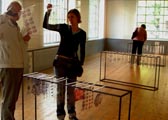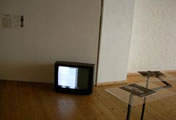


| -> ARTWORKS |
connexin
ausstellung, brick5
wien 2006
 |
 |
 |
click on image to enlarge |
Konzept "connexin" Connexin ist ein Protein welches den Austausch von Substanzen zwischen benachbarten Nervenzellen ermöglicht. Insbesondere interessiert mich die Analyse der Semantik wissenschaftlicher Abbildungen mittels künstlerischem Ausdruck. Wieso die Situierung jener Auseinandersetzung gerade innerhalb des Kontextes Kunst? Die Bilder der Naturwissenschaften sind traditionellerweise geschichtslos, da ihre Funktion in einer reinen Beschreibung der Natur liegt. Durch den "Blick von Außen" der Kunst, kann es möglich werden, diese zu trans-formieren und in einen (neuen) geschichtlichen Bezug zu stellen, wie auch Zusammenhänge zwischen wissenschaftlichem Text und Bild zu ent-decken die einer reinen wissenschaftlichen Lektüre verborgen blieben. Parallel zu diesen streng konzeptionellen Zugang entstehen Arbeiten die auf freiere und intuitivere Weise mit wissenschaftlichen Konzepten umgehen. Connexin is a Protein that allows an exchange between neurons. Zu: "Brain" Zu: "Entropie nr 2" Zu: "Physics Today:Lise Meitner´s Maschine" Interview zur Ausstellung
|
Text von Stephen Zepke über die Ausstellung I first met Claudia at the Akademie some years ago, where she was one of the most outstanding students that it has been my pleasure to teach. She graduated last year and it is a great to introduce this work of hers, which is developing her themes in such exciting ways. Claudia already had an academic career before studying Fine Arts. She received her PhD from Vienna University in 2001, her dissertation being on "Nonlinear and Neuronal dynamics: A relational Approach". So, as is always the case with art, her work here has a strongly auto-biographical element. The element I`d like to talk a little about tonight however, is the brain. The brain is central to the work here, and to Claudia`s larger project involving the intersection of science and art. This is an intersection that the brain traverses, not so much as a thing in common, but as a break. A break that Claudia utilises to give back to science another image of the brain, and a new mechanism of thought. We start with scientific images of the brain. These are drawn from the prestigious publication "Brain: A journal of Neurology" and mainly show "brain-slices", cross-sections revealing various types of brain activity. These are arranged in chronological order, from 1976 to the present day, allowing us to examine the changes and consistencies in the aesthetics of such a representation. This is a project that follows the work of Bruno Latour in revealing a semantics of scientific representation and historicizing the objectivity of the scientific image. This would be to follow a kind of aesthetic unconscious at work in scientific images of the brain, providing an artistic impulse to the representation of scientific fact. But Claudia takes this project further, because her work demonstrates how this aesthetic unconscious implies a different brain from the one mapped in the " brain slices". These images represent measurements of brain activity. What is nice is that they usually measure abnormal activity, which appears in later images in areas of bright colour. Normality is what does not appear, or appears as a kind of bland background on which the aesthetic beauty of "sickness†blooms. This indicates, as Nietzsche would say, the greater "health†of art. But the problem with representations of the brain is that measuring electric or chemical processes in the brain does not explain why they occur. In fact science has had a hard time explaining how the brain works. It is no accident that much recent research " such as Claudia´s " uses non-linear dynamics and chaos theory to explain the brain´s complex processes. Now the brain is a "phase-space†functioning according to the operation of "strange attractorsâ€. As beautiful as these metaphors are they still give rise to representations that while including uncertainty and "fuzzy logic†nevertheless approach the brain as an object of science. The brain-space is established as the measured object of scientific inquiry, a space confined to the realm of subjective interiority. This interiority maintains an organic relation to its outside world by processing the sensual information that comes from it. This is where Claudia offers us a valuable insight. The brain, as it appears here, is not an object of study but the terminus formed through the aesthetic encounter. Or rather, Claudia takes the interior space of the brain as object of measurement and directly confronts it with its outside of collective action. Her work invites us to enter into its process of composition, as we pick up and look through the "brain-slices". Participation becomes the medium of thought, and the opposition of interior and outside necessary for measurement becomes a break through which thought emerges, a "between" generated by our encounter. Claudia´s work becomes a kind of "world-brain" in the process of being thought. As Deleuze and Guattari would put it, the brain becomes here a Body-without-Organs. We are in the middle of the break between science and art. A productive break appearing as the model for thought and offering back to science a new brain. Here the brain is an "interface†of inside and outside acting as the fold of thought. The break marks the flows that come together to create it, and is inseparable from the creation of new flows. The brain therefore functions as a disjunctive-synthesis that introduces a non-quantifiable movement into the calculations of science. Thought emerges in and as the world, and Claudia invites us here to embody it, to affirm the immeasurable creative powers of a communal thought. I want to finish by briefly exploring this idea through three aspects of her work. 1) Claudia converts "brain slices" from information into aesthetic process. She converts them from something to be read into things to be seen and felt, to be handled and manipulated by the body as much as the brain. She introduces a somatics to the semantics of the image by a very precise intervention. She removes the neutral background from the images, a background that isolated the brain under the scientific gaze. This "removal of the removal" makes the brain appear in the middle of things. 2) This allows the "brain slices" to go back over the "break" that science imposes between the image and its object, and the object and the world. Claudia re-materialises these breaks to turn the brains from representations into something real, or better and like Godard, she reveals the reality of the representation. The use of minimalist references in the mise en scene is no accident then, because Claudia´s work allows her materials to become directly expressive. Thought has found its true materiality, and the brain´s plane of immanence now extends to the ends of the earth. 3) But we cannot understand this materiality, this matter of the brain, without understanding this break or gap once more, now as the space of our encounter with the work. The work therefore functions similarly on macro and micro levels " its fractal we could say " because the break it introduces between the scientific representation and the materiality of thought is the one that plays out between the work and its outside: us, its users. Because the thought of this exhibition, the exercise of its brain, is to give an encounter, an inter-action, between us and it, as much as between science and art, an encounter of inside and an outside that occurs through and across their break. This break, this work, is thought as a process of collective experimental action, a brain that operates through play. So all that remains is for me to invite everyone, everyone as collective-brain, to think. Which means to play. |